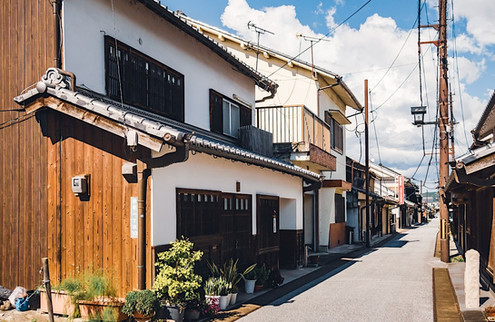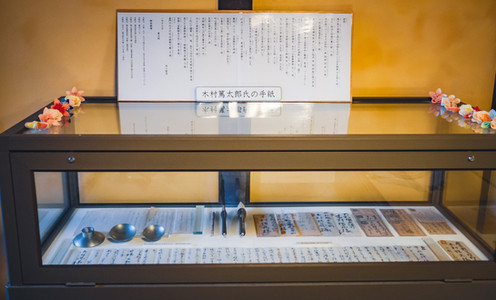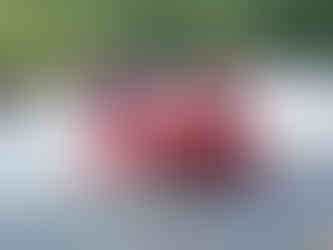Things To Do In Gojo City
- NARA Visitor Center & Inn
- Mar 21
- 14 min read
Updated: May 6
Gojo City is a hidden gem brimming with historical allure and a touch of retro charm.
Often utilized as a stop on the way to Koyasan; it's a destination in its own right. As you traverse the town's most famous street, Shinmachi-dori, once bustling with merchants and traders during the Edo period and now flanked by two conveniently located train stations, you'll be drawn into its unique ambiance whispering tales of bygone eras. The machiya houses have found new life as cozy cafes and intriguing galleries, somewhat akin to Naramachi or Imai-cho. In 2010 the government designated this area as an "Important Preservation District for Groups of Historic Buildings."
But Gojo isn't just about history; it's also a place where nature and adventure meet. The Yoshino River invites thrill-seekers to delve into activities like rafting and kayaking.
Gojo is famous for persimmons and produces more than any other area of Japan. The sloping landscape, clean water and extreme temperature differences between night and day make the ideal environment for growing high-quality persimmons.
With a population of around 27,000, Gojo is the serene yet vibrant interlude your journey in Japan deserves. So, whether you're pursuing history, adventure, or simply a taste of tranquil charm, Gojo welcomes you to explore its streets, stories, and soul.
Shinmachi-dori Street
'Gojo Shinmachi' is designated as an 'Important Traditional Building Preservation District,' characterized by houses built from the early 17th century to the early 20th century. Shinmachi-dori Street stands as a remarkable historical treasure, a living testament to generations of heritage and enduring charm. Alongside this storied thoroughfare lie a number of compelling landmarks, each steeped in the rich narrative of the area’s past. Among these are the Yoneyama Family Residence, a National Important Cultural Property; the Nakaya Residence, designated a Prefectural Cultural Property; and the Kuriyama Family Residence, a City Cultural Property and one of the oldest surviving private homes in Japan.
It's an enchanting area where you can witness the evolution of homes over approximately four centuries, from the Meiji, Taisho and the early Showa eras. Gojo's machiya are primarily two-story buildings, with the second floor traditionally used as attic storage. This design results in low eaves, lending the street a cohesive and orderly appearance. The upper walls and undersides of the eaves are thickly plastered using the soekui technique, while mushiko-mado lattice windows add to their character. Roofs vary between formal hon-gawara tiles and simpler san-gawara tiles.
Despite these shared features, no two houses are identical. Each combines these elements uniquely, creating subtle variations that enrich the street’s visual appeal. Shinmachi Street, lined with these historic homes, preserves a distinct atmosphere and remains a cultural treasure worth safeguarding for future generations.
Here is a brief rundown of some of the highlights on Shinmachi-dori Street.
Sakamoto Poultry Hitotsubashi Branch Office
Sakamoto Poultry is in the location of Shinmachi's famous mochi shop. As readers of Japanese can see, the signboard above the shop still has the Chinese kanji for mochi clearly displayed. The third-generation owner operated the store until December 2018, when, due to old age, they closed it down. The building was aging and became an empty storefront. But the shop was such an iconic symbol of the area that the locals banded together to brainstorm ways to keep it going.

A Storefront of History - The store was founded in the Taisho era. It was known for its large sign, five meters in width, with the name "Mochishou Hitotsubashi" written from right to left. Situated at the first bridge of the street (when counting from the eastern end of the street) it acquired the name "Hitotsubashi" (First Bridge), and it wasn't long before the store and the bridge became the default image of Gojo City.
With the assistance of Nanto Bank's Regional Business Creation Department, dedicated to promoting tourism and community development in Nara, a revitalization project was designed to entice businesses such as dining, retail, and takeout to operate the store in the hopes of it becoming a beacon of revitalization for the whole area. These types of short -lease, financially supported businesses are known as Challenge Shops in Japanese.
The project invites entrepreneurs to lease the premises for 2 years at a very reasonable rate of just $400 pcm. As mentioned above, the current tenant is Sakamoto Poultry, a poultry farm run by 2 sisters. The shop operates as a satellite to their main store which is just a 5 minute car-ride away. After their father suddenly passed away, they were left with a life-changing decision of either individually finding their own way in life or combining their talents by taking over the family farm and modernizing it in their own image. After much deliberation, they decided to take up the mantle of poultry farmers and set out on a mission to create a business with deliciousness and happiness as its guiding principles.
For the 2 years prior, Choco Banashi who specializes in small-batch hand made chocolate were operating here. Choco Banashi was a big success and they have expanded their operation after their 2 year lease ended in mid 2024. Choco Banashi did a great job of being part of the "Symbol of Gojo" and Sakamoto Poultry are more than worthy successors. We are looking forward to seeing how they grow from here on out as well as who nexts takes up the mantle in 2 years time.
Address: 1 Chome-3-1 Gojo, Nara
Tel: 0747-26-5005
Hours: 10:00 – 16:00
Closed: Tuesday
Machiya-kan
A building from the late Edo period, imposing and beautiful.
Having weathered the centuries, this structure has been meticulously restored to offer a glimpse into the life of a machiya from yesteryear.
Machiya-kan itself is an exhibit. Inside, you'll find the traditional architecture of an Edo-period machiya, complete with a well, a hearth, and a box staircase - a portal to a bygone era, where you can step back in time and experience life as it once was. Additionally, in a dedicated corner, discover the legacy of the political figure, Tokutaro Kimura, born right here in Machiya-kan. The corner houses a treasure trove of invaluable materials related to this great figure. Tokutaro Kimura, the first Director-General of the Security Agency, was born in Gojo in 1886. He assumed the position of Attorney General in 1946. In the same year, he became the Minister of Justice. Additionally, Tokutaro Kimura held positions such as the President of the Tokyo Bar Association and the President of the All Japan Kendo Federation.
As an architectural gem, it stands out even in the midst of the mesmerising buildings along Shinmachi-dori Street. Once you step inside, you'll discover a beautifully maintained space. The building is situated on the north side of Shinmachi-dori Street which is slightly curved, resulting in some irregularity in the rooms along the roadside. It adopts the traditional architectural style of a machiya, believed to date back to the late Edo period. Its roof is adorned with hongawarabuki (flat tiles) in a kirizuma-zukuri (gable) style, while the exterior walls are finished with shirakabe-koshiita (white plaster with waistboard).
Address: 2 Chome-6-6 Honmachi, Gojo, Nara
Tel: 0747-23-2203
Hours: 10:00 – 16:00
Closed: Monday & Thursday
Admission: Free
Diorama Factory Y.N
After retiring in 2012, Mr. Yasunori Noguchi continued to pursue his hobby of model kits which led him to participate in Shinmachi's regeneration project in which people could rent properties on a short-term basis to experiment with various business ideas.

His project was a success so he decided to solidify his commitment and opened "Diorama Workshop Y.N" in the same premises. His shop is full of rare model kits and some amazing dioramas for visitors to enjoy.
Diorama Factory Y.N is as much a museum as it is a shop. People are welcome to come in and have a look at the amazing content on display even if they have no interest in models or dioramas. The building's Edo-era aura really adds to the experience making a stop here on your journey through Shinmachi a must.
Mr. Yasunori Noguchi holds diorama workshops for children. He hopes that children will feel the excitement he felt as a child when he encountered model kits.
Address: 1-6-6 Shinmachi, Gojo, Nara
Tel: 090-4908-3952
Open: Fri, Sat, Sun & National Holidays
Hours: 10:00 – 16:00
The Machinami Denshokan
The Machinami Denshokan, or Streetscape Heritage Hall, was established in 2003 as part of Gojo City's Shinmachi District Streetscape Environmental Improvement Project. Originally built during the Meiji and Taisho eras, the structure once served as a private residence and later as the town hospital during the Taisho period. Restored with modern techniques, the building now stands as a symbol of efforts to preserve and pass down the legacy of Shinmachi Street. Traces of its history remain visible—including various documents and items and watermarks on the beams above head height, bear witness to a devastating flood that struck the town some 60 years ago. Today, the hall serves as both a museum and a community hub for sightseeing such as strolling through the townscape and is complete with public toilets. Its design reflects the philosophy of "learning from the past to create the future," with the building itself functioning as a gallery.
Spaces Within the Hall
Traditional Japanese Rooms (46.57m²): Preserved in their original machiya-style design from the Meiji era, these three 8-tatami mat rooms provide a serene and versatile space for various uses.
Gallery (54.75m²): This area displays artifacts and materials related to Shinmachi Street and its historical surroundings.
Exhibition Room (59.44m²): A spacious area designed for showcasing photographs, paintings, handicrafts, and other works. When not hosting planned exhibitions, this room is available for public use.
Usage Fees
Japanese Rooms: ¥200 per hour (¥100 for heating/cooling)
Exhibition Room: ¥500 per day (¥300 for heating/cooling)
The Machinami Denshokan offers visitors an opportunity to connect with Shinmachi Street’s rich history while fostering creativity and community within its carefully preserved walls.
Access:
Address: 2 Chome-7-1 Honmachi, Gojo, Nara 637-0041
Tel: 0747-26-1330
Hours: 9:00 AM to 5:00 PM (last entry at 4:00 PM)
Closed: Wednesdays (or the following day if it falls on a holiday) and from December 25 to January 5 for New Year’s holidays.
Fee: Free
Goshin Railway Line
Halfway along Shinmachi-dori Street you will walk under a nostalgic-looking arch bridge - you may even be forgiven for not noticing that it simply ends in mid air. This is the remnants of the Japanese National Railways Goshin Line.
In the late Meiji era, plans were made for the "Goshin Railway," which would connect Gojo City to Shingu City in Wakayama Prefecture via Totsukawa Village. This railway line was intended to transport timber resources, including valuable Yoshino cedar, from the forests in the region.
Construction began in 1937, with progress made on elements like the bridge supports across the Yoshino River and the excavation of the Obusu Tunnel. However, the outbreak of World War II and resource shortages forced the project to be suspended.
After the war, construction resumed, and by 1959 roadbed work was completed between Gojo and Jodo in Nishiyoshino Village (now part of Gojo city). Only the track installation remained incomplete between Gojo and Jodo. However, due to changing economic and social circumstances, the Goshin Railway was never realized and was officially cancelled in the late 1980s.
Despite its cancellation, the Goshin Line left behind remnants such as bridge supports and tunnels that serve as historical artifacts today.
Address: 1 Chome-10-20 Shinmachi, Gojo, Nara 637-0043, Japan
Hours: 24hrs
L’Ami d’Enfance à la Maison
At the end of Shinmachi-dori Street lies L’Ami d’Enfance à la Maison, a French restaurant that celebrates local produce within a 200-year-old Edo-period building.

The name, L’Ami d’Enfance, meaning “childhood friend” in French, evokes a sense of familiarity and warmth. Coupled with the rustic charm of the countryside and traditional architecture, it invites you to slow down and savor both the food and atmosphere. Chef Hideki Katayama’s menu is a tribute to local produce, featuring vibrant seasonal vegetables grown in Gojo’s rich soil and nourished by its pristine waters. His dedication extends to house-made charcuterie—carefully cured hams, smoky bacon, and rich apple butter—as well as locally sourced game from Gojo’s forests.
In this 200-year-old Japanese house, classic French cuisine becomes more than just a meal—it’s a cultural crossover that invites guests to savor both tradition and innovation in every bite.
Address:: 637-0071, Nara Prefecture, Gojo City Futami 1-9-28
Hours:
Lunch: 11:30-15:00 (Weekdays from 12:00 PM) Last Order: 13:30
Dinner: (Reservation Required) 18:00 – 22:00 Last Order: 20:30
Closed: Wednesdays
Menu du Jour: ¥4,000
Special Lunch: ¥5,200
Dîner du Jour: ¥9,000
Chef’s Selection: ¥11,500
All of these places and more can be found along Shinmachi-dori Street.
Let's take a look at what else is on offer in the rest of the city.
Restaurant Yoshinogawa
Restaurant Yoshinogawa boasts a captivating view through its generously sized windows. Views that are almost as captivating as the dishes on their menu. These windows frame a scene that changes dramatically with each passing season, as the surrounding trees and the gentle flow of the Yoshino River create an ever-shifting tableau. Each season brings its own charm, and the restaurant harmonizes its menu with these changing rhythms of nature, taking advantage of locally grown produce.
Inside, the ambiance is steeped in Japanese tradition, offering a serene escape from the ordinary. A small stream runs down the center of the dining area, populated by graceful koi and goldfish. It's a stylish touch and kids make get the chance to feed them too. The restaurant has earned distinction in Nara Prefecture's initiative to recognize establishments offering not only exquisite cuisine but also exceptional views. Moreover, it has made a dedicated commitment to sourcing ingredients locally, championing the unique flavors of Gojo.
In spring, patrons can relish the delicate taste of bamboo shoots, while summer brings the delectable cherry salmon. As autumn descends, diners can savor the richness of persimmons. The menu thus changes harmoniously with the seasons, ensuring that each visit to Restaurant Yoshinogawa offers a fresh and authentic experience of Gojo's bountiful produce.
Address: 449-1 Kojima-cho, Gojo
Tel: 0747-230-123
Hours:
Mon-Fri: 11:00 – 15:00
Sat - Sun: 11:00 – 15:00 & 17:00 - 19:30
Closed: Wednesday & 3rd Tues of the month
Admission: Free
Ever Green
Canyoning, rafting, snowshoeing, trekking - if you love outdoor adventures then Ever Green is the company for you. With river based activities based in Gojo city and mountain activities stretching further afield into Yoshino, whatever the season, Ever Green has an adventure waiting for you that takes full advantage of the gorgeous natural environment that the area is blessed with.
Ever Green has built quite a reputation with their canyoning adventures, offering expert guidance through thrilling descents on natural water slides, challenging climbs up imposing rock formations, and refreshing dips in clear pools. If you're looking for a different adventure, you might consider their packrafting excursions, navigating forested waterways on your own compact inflatable raft. Families are welcome too, with group rafting trips suitable for kids as young as four.
There are also enticing trekking journeys and even relaxed tree-climbing activities. On certain dates, you can join extended expeditions that include overnight stays in this natural wonderland.
Keep in mind, some activities require you to bring some of your own gear like towels and swim wear, but they also offer equipment rentals for certain items. If you need any help with bookings or inquiries, drop us a line at info@sarusawa.nara.jp and our staff will gladly help you out.
Address: 1260 Sanzaicho, Gojo, Nara 637-0002
Tel: 0747-23-0620
Office Hours: Spring - Winter 09:00-18:00
Fees: Depend on length and type of tour. See their official website for details
The Kaki Persimmon Museum
The Kaki Persimmon Museum, located within Gojo City, was established in 1994 with the aim of collecting and preserving the valuable history and utilization of persimmons in all forms as well as disseminating information about this nutritious orange fruit to the general public.
e Kaki Persimmon Museum is a unique museum that showcases the history, culture, and uses of persimmons with a collection of over 500 items related to persimmons, including traditional tools, clothing, and artwork. Visitors can learn about the different varieties of persimmons, their health benefits, and the ways in which they are used in Japanese cuisine. The museum also features a small orchard where visitors can see persimmons growing and even try some of the fruit.
The building is shaped like a persimmon fruit, constructed by connecting 236 triangular aluminium panels. It stands at a height of 8.7 meters and has a diameter of 18.2 meters. From late September to early December, approximately 200 varieties of fruits cultivated at the Fruit Tree and Medicinal Herb Research Center (located on site) are put on display. In the center of the building, there is seating for 50 people and a 100-inch screen where films and videos about persimmons are shown. The museum is predominately utilized as an educational venue for elementary school students but also serves as a place for interaction between general consumers and producers.
Address: 1345 Nishiyoshino-cho Yushio, Gojo, Nara 637-0105, Japan
Phone: 0747-24-0061
Hours: 9:00 - 16:30
Closed: Monday
Admission: Free
Places to Stay
Oto Cosmic Park Hoshi-no-Kuni
Oto Cosmic Park Hoshi-no-Kuni, perched atop Michinoeki Yoshino along Route 168, is a serene retreat offering amazing views of Mount Yoshino. Established in 1986, during the approach of Halley’s Comet, the park was originally part of the Oto Village Astronomy Learning Center. Today, it remains a popular destination for stargazing, with its main observatory featuring a 45cm reflecting telescope. The park is conveniently located near several restaurants, rest areas, and hot spring baths, making it an ideal stop for travelers seeking both relaxation and a glimpse of the cosmos.
Lodge Hoshi-no-Kuni
For those wishing to extend their stay, Lodge Hoshi-no-Kuni offers a peaceful escape infused with the calming scent of wood. The lodge features both traditional Japanese-style tatami rooms and Western-style rooms with lofts to accommodate larger groups or families. Guests can enjoy traditional Japanese kaiseki meals for dinner.

Western-Style Room (1 room, 2–5 guests)
This modern Western-style room features an 8-tatami mat-sized hardwood floor area with a loft. It accommodates up to 5 guests: 2 in beds, 1 on an extra bed, and 2 on futons in the loft. An extra bed is available upon request.

Japanese-Style Room (1 room, 2–6 guests)
This spacious 10-tatami mat Japanese-style room can accommodate up to 6 guests. The large room provides plenty of space to relax and unwind in comfort.
Prices start from 2 guests per room: Adults ¥14,500 / Children ¥11,000

Bungalows with Domes
For a more private experience, the park offers bungalows equipped with dome-shaped observation rooms on their roofs, allowing guests to enjoy stargazing from their own space. Each bungalow also includes a kitchen on the first floor, making it perfect for families or groups looking to spend an intimate evening under the stars. Price per night is ¥30,000 for up to 5 people and then a further ¥3,000 per person from the 6th. There are no extra peak season charges. Maximum capacity is 10 people.
Log Cabins
The log cabins offer a rustic mountain lodge experience. These bungalows are designed for simplicity, with all water facilities located outside. They provide an authentic outdoor experience while still offering comfort. Price is ¥20,000 per night with no extra peak season charges. Maximum capacity is 6 people.

Barbecue House
Even in rainy weather, guests can enjoy outdoor dining thanks to the park’s covered barbecue house. This facility ensures that your barbecue experience remains enjoyable regardless of weather conditions.

Whether you’re stopping by for an afternoon or planning an extended stay, Oto Cosmic Park Hoshi-no-Kuni offers a rare blend of natural beauty and celestial wonder—a place where you can reconnect with both nature and the stars.
Access:
Address: 249 Otocho Sakamoto, Gojo, Nara 637-0417
Tel: 0747-35-0321
Hours: 8:30 AM – 5:30 PM
Closed: Wednesdays (except during public holidays)
Reservation required
Hotel KANAU Old Imperial Palace
Located quietly along the clear waters of the Nyu River, Hotel KANAU was born through the renovation of the former imperial residence of the Kanao family, designated as an Important Cultural Property of Japan. Located within the grounds of the former imperial residence where four emperors resided in the 14th century, this lodging is housed in a renovated Edo-era rowhouse.
Beautifully renovated and opened in April 2019, the hotel is available for exclusive rental, ensuring complete privacy with a variety of accommodation plans, from simple room-only plans to luxurious dinner-inclusive options. At their restaurant you can enjoy Western and authentic French cuisine or enjoy a barbecue right next to the hotel or by the nearby riverbank.
Hotel Kanau serves as a great base to explore the aforementioned Goshin Railway. The hotel is dog-friendly and even has a dog run. For the musically minded, there is an upright piano that you can play to your heart's content and you're welcome to bring your own musical instruments as well.
Address: 1 Nishiyoshinocho, Anou, Gojo, Nara
Tel: 0747-320-080
Yanaseya
Hidden away on Shinmachi-dori Street, you'll find "Yanaseya," a place where the echoes of a bygone era still linger. Nestled amidst the Edo-period townscape, this is a space that has exquisitely captured the essence of days long past.
There are no "rooms" here, you have the entire traditional machiya house all to yourself, with two distinct structures on its property - the "kura" and the "hanare," each brimming with its own unique charm.
Meals are served at Gojo Genbei, a traditional Japanese restaurant and cafe located opposite.
Address: 2 Chome-7-3 Honmachi, Gojo, Nara
Tel: 0747-25-5800
Farm Stay Komorebi
Farm Stay Komorebi offers a serence glamping getaway on a 150-year old persimmon farm. They also operate a cafe and sell produce direct to the public. An idyllic retreat that shares the charm of countryside living with a few creature comforts thrown in.
A great BBQ area is also available accommodating up to 12 people. Facilities include:
BBQ Grill (charcoal)
Fridge/Freezer
Running Water
Portable Gas Stove
Power Outlet
Campfire Pit (10 firewood pieces)
The glamping tents are spacious and bedding is provied for up to 4 people. There is enough room available if you'd like to bring your own tents, allowing more people to stay at no extra cost.
At the end of the day, relax in the jacuzzi at the on-site cafe. Towels, hairdryer, shampoo, and soap provided.
Address: 210 Nishiyoshinocho Yushio, Gojo, Nara
Tel: 0747-320-600
Things To Do In Gojo City
We hope you enjoyed reading Things To Do In Gojo City, if you have any questions, suggestions or requests for future articles, please get in touch.
Author: NARA Visitor Center & Inn
































































































































































































